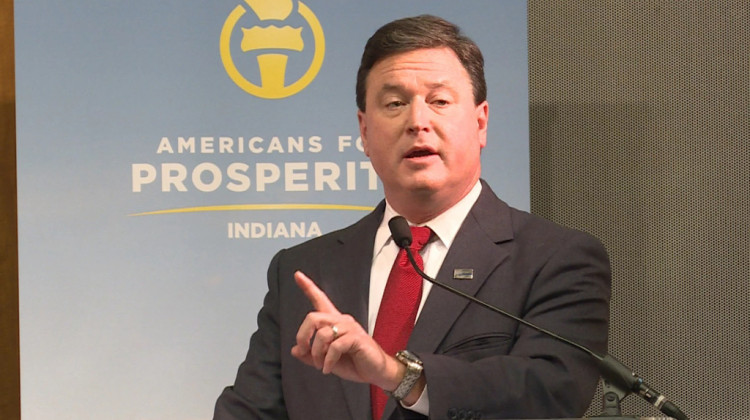
Aja Yasir has worked hard to keep her garden in Gary, which she named “A Rose for Yaminah” after her daughter who passed away.
Rebecca Thiele / IPB NewsNative plants aren’t just good for birds and bees. They also make the land more resilient to the effects of climate change and can even help prevent it. But cities and homeowner’s associations don’t always like the way they look — putting them at odds with residents who want to grow native plants in their yards.
Some cities and HOAs in Indiana are working with these homeowners to encourage these plants.
A fight for food instead of lawns
Aja Yasir’s yard in Gary is full of flowers, food and medicines. Many of these plants are indigenous.
“I was excited today. Some people might not be excited to see this, but I was excited to see some fleabane growing — which is an indigenous plant. It's also medicinal," she said. "I feel like every time I see more and more plants just show up, I feel like, 'OK, I'm doing something right.'"
Yasir and her family bought this once vacant lot in 2016, just a few months after her daughter passed away. Before they even moved in, she would travel to and from Illinois every day — building up the sandy soil with leaves, cardboard, compost and wood chips.
“That was the only way I could get through it. And so it has been like an asylum for me. It's been an emotional release. It’s also been a way to feed my family. It’s been a lot for us," Yasir said.
[YASIR PHOTO]
But not everybody liked the look of Yasir’s yard. She got a citation from the city in 2017, but the judge threw it out. To her surprise, she received another citation the following year. That one took a year-long court battle to resolve, but with the help of a nonprofit defense fund that protects farmers — she won.
Still, even today, it’s a struggle for Yasir to keep her plants. Earlier this summer her utility chopped up her apricot and nectarine trees. She said she probably won’t get fruit from them this year.
“It's been exhausting. The whole thing has been absolutely exhausting," Yasir said.
Yasir isn’t alone. Some homeowners that have converted their lawns to native plants have gotten slapped with fines or even had their yards mowed without permission. The reason? Taller native plants can get mistaken for weeds. Many cities don’t allow weeds to grow above a certain height and they don’t take the time to find out what’s what.
Native plants have many planet-friendly benefits
They keep the land cooler. Native plants tend to be taller, so they provide more shade. They also use heat from their environment to pull water up from the soil and out their leaves in something called evapotranspiration.
“It’s a process that actually removes energy from the system, thus cooling the air. It's the exact same principle as sweating," said Heather Reynolds, a biology professor at Indiana University.

Native plants also do more to prevent flooding. Reynolds said mowed grass is all one length — so it doesn’t trap water as well as native plants can during a heavy rain. Native plants also have longer roots, which keep the soil in place and help it absorb more of that water. Those taller plants with taller roots can trap more carbon dioxide too.
Then there’s all of those high maintenance things you need for a lawn that you don’t need for native plants.
“They require little — if any — fertilizer, pesticides, irrigation and of course they aren't going to require mowing. All of these inputs generate greenhouse gas emissions," Reynolds said.
That means maintaining native plants likely doesn’t contribute to climate change. Because of these benefits and others — some cities have started to work with homeowners to encourage native plants.
Separating the natives from the weeds
“This one is an example of a yard that's actually in compliance yet we get a lot of complaints about it," said Linda Thompson.
Thompson is the senior environmental planner in the city of Bloomington's planning and transportation department. If a Bloomington resident gets a complaint about weeds, but they say they’re native plants — it’s Thompson’s job to go find out.
She said she can identify a lot of plants already, but when she’s stumped she uses an app.
“Looks like it is a Chinese clematis. So I’ll have to go back to the office and look that up," Thompson said, after getting results with a picture app.
Bloomington changed its ordinance to define a weed as an invasive plant — a plant that can spread out of control and prevent other plants from growing. Thompson said homeowners in Bloomington can plant almost anything they want in their yards as long as it’s not invasive and doesn’t block traffic sight lines or sidewalks.
“I searched all over the place for a definition for weed and there isn't one — except a plant that's growing somewhere where you don't want them to grow. It's all a matter of aesthetics and the city does not enforce, you know, aesthetics," she said.
Indianapolis encourages residents to plant natives — but it does it a little differently. You can get your native plant garden certified by the city through its Native Planting Area Program to make sure you don’t get fined.
St. Joseph County updated its ordinance to specify that things like native plant gardens, rain gardens, food crops, buffer strips and wetland vegetation aren’t to be considered weeds.
Aside from government ordinances and programs, anyone in the state can apply for a certification through the Indiana Native Plant Society and purchase a sign.
But even if your local government allows it, your homeowner’s association might not.
Negotiating with the HOA
About six years ago, Zac Sprunger got a letter from his HOA in Carmel saying his plants were too tall.
“Instead of freaking out and being confrontational, I just called some HOA board members and had a conversation to explain why I was doing what I was doing," he said.
They came to an agreement. Now Sprunger has what he calls a “mullet” — with shorter native plants in the front yard and taller ones in the back.
“The idea is any of our neighbors walking along the sidewalk would just see a normal house," he said.
Sprunger also joined the HOA board and works to put native plants in common areas around the neighborhood.
Join the conversation and sign up for the Indiana Two-Way. Text "Indiana" to 73224. Your comments and questions in response to our weekly text help us find the answers you need on statewide issues, including this series on climate change and solutions.
Still, only a handful of HOAs and local governments in the state are encouraging native plants. In order to see more, Aja Yasir said Hoosiers will have to change their ideas of what a residential yard can be.
“If I were thinking of a utopian world, everybody would be growing their own food. People will be trading food. And it would just be beautiful. You wouldn't have abandoned places because you would find use for abandoned places. But it starts with the people," she said.
Native plant gardens are "contagious"
Even though planting a native garden is one small thing you can do for the planet, it can have ripple effects. Linda Thompson with the city of Bloomington said sometimes you'll see one homeowner plant native plants and then suddenly they pop up in neighboring yards too.
"One person does it and then the next person does it and the next person," Thompson said. "Yeah, it's contagious."
If you're interested in creating your own native plant garden, the Indiana Native Plant Society has resources on how to get started on its website under the landscaping tab. You also might try contacting your local Soil and Water Conservation District.
CORRECTION: A previous version of this story misspelled Zac Sprunger's first name.
Rebecca is our energy and environment reporter. Contact her at rthiele@iu.edu or follow her on Twitter at @beckythiele.
 DONATE
DONATE







 Support WFYI. We can't do it without you.
Support WFYI. We can't do it without you.